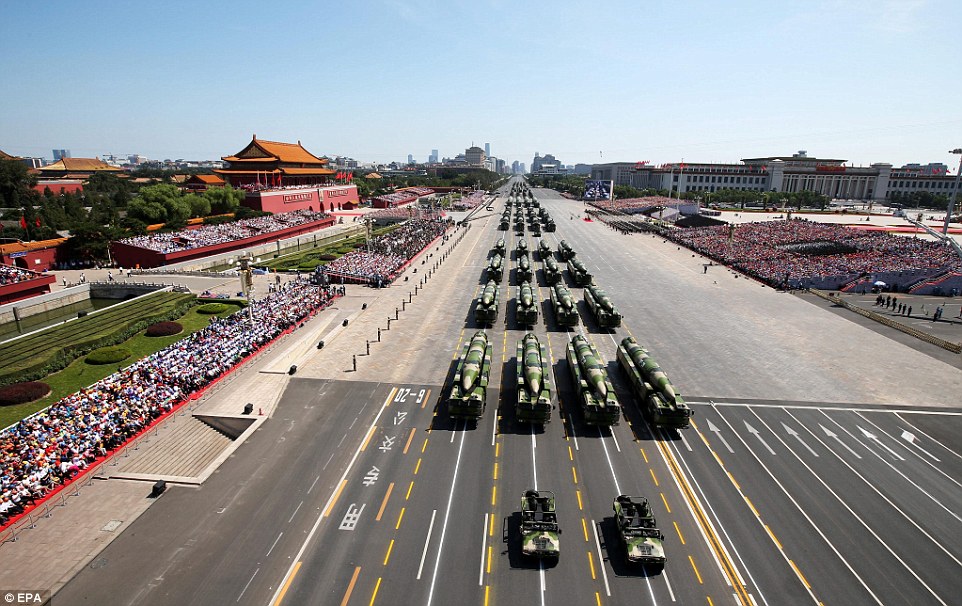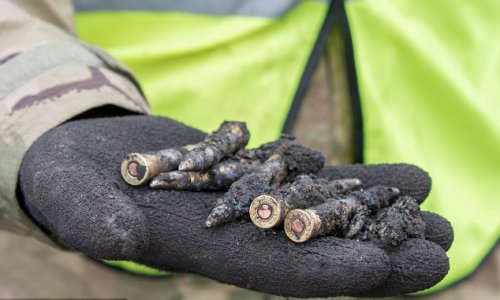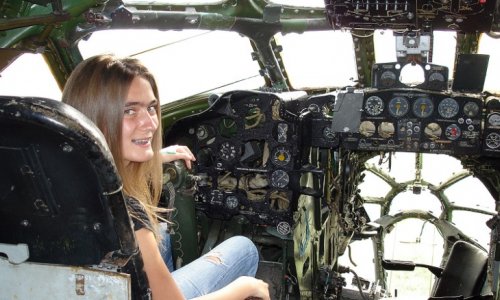China held its biggest display of military might in a parade to commemorate victory over Japan in World War Two – and among the weapons unveiled for the first time was an anti-ship ballistic missile which is reportedly capable of destroying an aircraft carrier with one hit.
The much-feared Dongfeng-21D can apparently strike a powerfully defended moving target with pinpoint precision.
It would penetrate defences because its incredible speed from launch would not allow enough time for carriers or other large vessels to complete counter-measures.
However, if locals had wanted to catch a glimpse of this and the rest of China's arsenal, they would be disappointed... as they were banned from watching the display.
More than 12,000 troops and hundreds of tanks and missiles rolled through Tiananmen Square in Beijing as fighter jets and bombers flew overhead in an ostentatious show of force that lasted around 90 minutes.
But barricades were set up hundreds of metres from the parade and squads of police and volunteers blocked access to the deserted streets.
Residents whose homes overlooked the route itself were even ordered not to go onto their balconies or open their windows.
'Of course I'm proud, I'm Chinese,' translator Zhao Yufeng said. 'But I think people would feel more involved if we could see the soldiers and tanks.'
Crowds of around a hundred citizens gathered to try to catch a glimpse of the hardware as it rolled by in the distance, but were disappointed.
Instead, most watched the live broadcast on mobile phones as the city took on an atmosphere of years past, with residents sitting out on the streets chatting or playing cards.
A man in his 20s surnamed Guo said he understood the need for security, but was sceptical of the authorities' handling of the event.
'We've been brainwashed from such a young age to hate Japanese, we call them ghosts, so it's easy for the leadership to justify a massive show of force today,' he said.
But as President Xi Jinping began speaking, Guo cut the live broadcast and pocketed his smartphone. 'He's not going to say anything interesting,' he said.
For some, the parade restrictions were an expensive imposition.
Wang Xingyu and his wife have a noodle shop close to the parade route and sleep in a room behind the kitchen. They only go home to visit their families in the mountainous northern province of Shaanxi once a year.
They are open seven days a week, but their hard work has been interrupted by the commemorations, which saw them forced to close for two days.
'We're losing money and no one cares about us,' Wang said, visibly flustered. 'Maybe if we could open, people would come, eat and they could watch the parade on our television.
'Instead, everyone is just standing around here with nothing to do,' he added. 'And we can't even see anything!'
President Xi Jinping announced at the parade that he would cut troop levels by 300,000.
China's confidence in its armed forces and growing military assertiveness, especially in the disputed South China Sea, has rattled the region and drawn criticism from Washington.
Xi, speaking on a rostrum overlooking Beijing's Tiananmen Square before the parade began, said China would cut by 13 per cent one of the world's biggest militaries, currently 2.3-million strong.
He gave no timeframe for a reduction that is likely part of long-mooted military rationalisation plans, which have included spending more money on high-tech weapons for the navy and air force. Troop numbers have been cut three times already since the 1980s.
'Prejudice and discrimination, hatred and war can only cause disaster and pain,' Xi said under a clear blue sky. 'China will always uphold the path of peaceful development.'
He then descended to Beijing's main thoroughfare and inspected rows of troops, riding past them in a black limousine and bellowing repeatedly: 'Hello comrades, hard-working comrades!'
More than 12,000 soldiers, mostly Chinese but with contingents from Russia and elsewhere, then marched down Changan Avenue, led by veterans of World War Two carried in vehicles.
They were followed by ballistic missiles, tanks and armoured vehicles, many never seen in public before. Advanced fighter jets and bombers flew overhead in a highly choreographed spectacle that lasted around 90 minutes.
Also shown were several intercontinental ballistic missiles such as the DF-5B and the DF-31A as well as the DF-26 intermediate range ballistic missile, dubbed the 'Guam killer' in reference to a U.S. Pacific Ocean base.
Greg Austin, a professorial fellow at the East-West Institute in New York, said the troop cuts had nothing to do with curbing military power.
'It's a determination to expand military power by redirecting money to higher impact, higher technologies, which can have more strategic effect,' he said, referring to the maritime, cyber and space frontiers.
Peng Guangqian, deputy head of China's Council for National Security Policy Studies, said the equipment on display was intended to show the combat readiness of the People's Liberation Army (PLA).
'This indicates a change of the PLA training strategy; with more focus on actual combat,' Peng told the official Xinhua news agency.
(Daily Mail)



















www.ann.az
Follow us !











